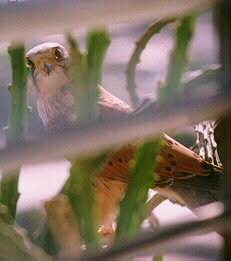Falcons
 One day, on March or April 1995, I found a brownish-spotted egg
in the cactus-pot on my window (on the 13-th floor). It turned out
(with a couple of other eggs that were added in the next few days) to
belong to
a pair of falcons (kestrels, to be more accurate) that liked my cactus,
and decided to use its pot as a nest. I closed the shutter
almost completely, in order not to frighten the mother.
One day, on March or April 1995, I found a brownish-spotted egg
in the cactus-pot on my window (on the 13-th floor). It turned out
(with a couple of other eggs that were added in the next few days) to
belong to
a pair of falcons (kestrels, to be more accurate) that liked my cactus,
and decided to use its pot as a nest. I closed the shutter
almost completely, in order not to frighten the mother.
And indeed she stayed there, set on the eggs until the chicks hatched,
while the male provided the food (mostly small lizards and birds). Then
she set on the young chicks until they grew up, and she could leave the
nest for longer and longer periods, and hunt for pray herself.
This is when I opened the shutter so we could see the chicks and take
some photographs of them. At first they have this
cute white down. Then the feathers start
to grow underneath the down until it
completely disappears, and they
look like a female. But the chicks
are not ready to fly yet. They can only flip their wings in a practice, or
just sit on the edge. When they are
ready, their mother seems to stop deliver the food, until the oldest (or
maybe the bravest) chick takes courage to leave the nest, and pray for
food for himself, and even for his siblings - even if it is just a
spider.
The next year they appeared again. This time laying 5 eggs. Lots of dirt
to clean after, but also a lot of fun. On the third year they didn't
arrive for some reason. Maybe the cactus on which they liked to stand grew
too much, or they found a better pot in the building. However, on May
there was again one egg in the pot. The female was again very shy and
scared. However, the male (which is a
little smaller then the female and have smaller dots on a redish-brown
background) didn't seem to mind my presence, and even was happy to pose
for the camera (see the picture above). Maybe he was one of the chicks
from the previous years. Maybe I frightened the female
too much, or maybe just because the nesting season was over -
they deserted the egg and my pot. There are still a lot of kestrels in the
building, nesting, sitting, and sleeping. But not on my window.
I can still
watch kestrels nesting in the university. But only from
some 20 meters apart, and with binoculars. It is nice but not as exciting.
But I will never forget this experience, and every time I hear
this voice, I
can't help raising my eyes and
looking for the beautiful bird hovering above, or standing and looking
curiously around.
In addition to the
Common Kestrel
(Baz Matzui) which is very common, we also
have in Israel the quite rare and endangered
Lesser Kestrel
(Baz Adom). They nest in very few places in Israel, including the
Musrara neighbourhood in Jerusalem, where they used to nest in the
tiles-roofs of old-styled houses. But when those houses were modernized
the kestrels were left with no place to nest, so a nesting-boxes project
was started. This project has evolved into an educational project, that
included Jewish children from Jerusalem, and Palestinian children from
Jericho where the lesser kestrels nest too. This project won the 1999
Time Magazine's "Heroes of the Planet" award.
Last updated on October 2003

 One day, on March or April 1995, I found a brownish-spotted egg
in the cactus-pot on my window (on the 13-th floor). It turned out
(with a couple of other eggs that were added in the next few days) to
belong to
a pair of falcons (kestrels, to be more accurate) that liked my cactus,
and decided to use its pot as a nest. I closed the shutter
almost completely, in order not to frighten the mother.
One day, on March or April 1995, I found a brownish-spotted egg
in the cactus-pot on my window (on the 13-th floor). It turned out
(with a couple of other eggs that were added in the next few days) to
belong to
a pair of falcons (kestrels, to be more accurate) that liked my cactus,
and decided to use its pot as a nest. I closed the shutter
almost completely, in order not to frighten the mother.